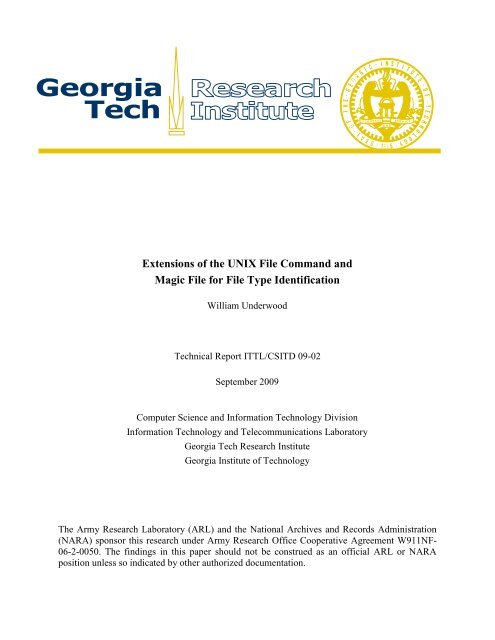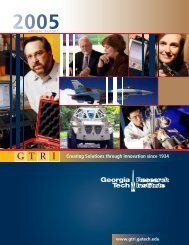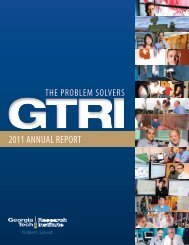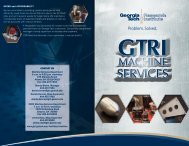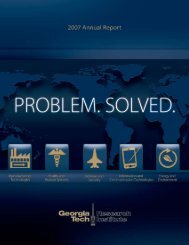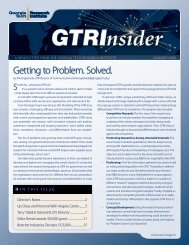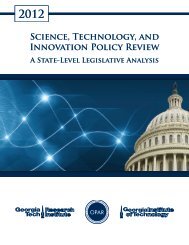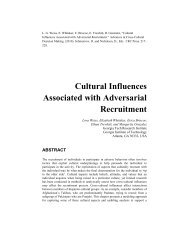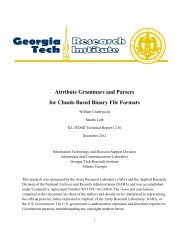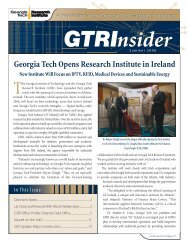Extensions of the UNIX File Command and Magic File for File Type ...
Extensions of the UNIX File Command and Magic File for File Type ...
Extensions of the UNIX File Command and Magic File for File Type ...
You also want an ePaper? Increase the reach of your titles
YUMPU automatically turns print PDFs into web optimized ePapers that Google loves.
An executable file is a serialization <strong>of</strong> encoded computer instructions. A script file is a file thatcontains instructions <strong>for</strong> an interpreter or a virtual machine.A data file is an external data representation in a sequence <strong>of</strong> bits <strong>of</strong> an internal datarepresentation that can be stored on a storage medium or transmitted across a communicationnetwork. When <strong>the</strong> resulting file is reread according to <strong>the</strong> file <strong>for</strong>mat, it can be used to create acopy <strong>of</strong> <strong>the</strong> original internal data representation.In object-oriented programming, serialization is <strong>the</strong> process <strong>of</strong> encoding an object into anarchitecture independent serial <strong>for</strong>mat <strong>for</strong> storage or transmission across a communicationnetwork. When <strong>the</strong> resulting series <strong>of</strong> bits is decoded according to <strong>the</strong> serialization <strong>for</strong>mat, it canbe used to create a semantically identical copy <strong>of</strong> <strong>the</strong> original object. Such methods <strong>of</strong>serialization result in persistent objects that because <strong>of</strong> <strong>the</strong>ir architecture independence are notsubject to obsolescence <strong>of</strong> computer plat<strong>for</strong>ms (hardware <strong>and</strong> operating systems). Examples <strong>of</strong>such <strong>for</strong>mats include <strong>the</strong> Hierarchical Data Format (HDF), Comma Separated Values (CSV), <strong>and</strong>JavaScript Object Notation (JSON).A file type (or file <strong>for</strong>mat class) is class <strong>of</strong> files with <strong>the</strong> same file <strong>for</strong>mat. A file <strong>for</strong>mat signatureis invariant data in a file <strong>for</strong>mat that can be used to identify <strong>the</strong> file type (or <strong>for</strong>mat) <strong>of</strong> a file. In<strong>the</strong> <strong>UNIX</strong> operating system (including flavors such as BSD, Linux <strong>and</strong> Solaris), file signaturesare referred to as magic numbers. In contrast to file <strong>for</strong>mat signatures, a file signature is achecksum or hash code <strong>of</strong> a file that can be used to check <strong>the</strong> integrity <strong>of</strong> <strong>the</strong> file2.1 External Format IdentifiersA unique identifier is needed <strong>for</strong> file <strong>for</strong>mats that is external to <strong>the</strong> file but can be linked to <strong>the</strong>file so that file signatures do not need to be checked every time a file is accessed. <strong>File</strong> nameextensions <strong>and</strong> metadata stored in <strong>the</strong> operating system are two approaches that are used. MS-DOS <strong>and</strong> Windows file names use a file name extension to distinguish different file types.However, file extensions alone are <strong>of</strong>ten not enough to discriminate file types. For instance, fileextensions such as DOC are ambiguous, since <strong>the</strong>re are several applications that create files withthat extension but have different file <strong>for</strong>mats. Fur<strong>the</strong>rmore, <strong>the</strong>re are WordPerfect documentfiles that do not have <strong>the</strong> .DOC extension recommended by <strong>the</strong> WordPerfect manual. Instead, <strong>the</strong>document creator avails himself <strong>of</strong> <strong>the</strong> filename plus <strong>the</strong> filename extension to create a longermnemonic filename. These extended names sometimes result in an extension used <strong>for</strong> ano<strong>the</strong>rfile type. For instance, SPEECH.COM is a user-created WordPerfect document file discoveredin <strong>the</strong> Bush Presidential e-record collection that contains a speech to <strong>the</strong> Commonwealth Club.However, <strong>the</strong> .COM extension is also used to represent a MSDOS compressed executable file.An alternative way <strong>of</strong> identifying file <strong>for</strong>mats was developed by Apple Computer <strong>for</strong> <strong>the</strong>Macintosh OS Hierarchical <strong>File</strong> System. Each program installed has an associated creator code.This is a 3-4 letter code that tells <strong>the</strong> MacOS Finder which program created a file in <strong>the</strong> filesystem. Each time an application writes a file to <strong>the</strong> file system, a creator code as well as a filetype code are stored as part <strong>of</strong> <strong>the</strong> directory entry <strong>for</strong> <strong>the</strong> file. The file type code is also a 3-4letter code that tells <strong>the</strong> MacOS Finder <strong>the</strong> <strong>for</strong>mat <strong>of</strong> <strong>the</strong> file. The combination <strong>of</strong> creator <strong>and</strong> file2
type codes is referred to as an OS<strong>Type</strong>. Both codes are needed because <strong>the</strong> same file type couldbe created by different applications.A Uni<strong>for</strong>m <strong>Type</strong> Identifier (UTI) is a string added to Mac OS X 10.4 operating system <strong>for</strong>uniquely identifying "typed" classes <strong>of</strong> items. For example, com.apple.pict is <strong>the</strong> UTI <strong>for</strong> <strong>the</strong>Apple Quickdraw PICT <strong>for</strong>mat <strong>and</strong> com.adobe.pdf is <strong>the</strong> UTI <strong>for</strong> Adobe PDF. UTIs are used toidentify <strong>the</strong> types <strong>of</strong> files <strong>and</strong> folders, clipboard data, bundles, aliases, symbolic links <strong>and</strong>streaming data. It was developed by Apple to eliminate problems associated with inferring afile's content from its file name extension, MIME type, or Mac OS<strong>Type</strong> code [Apple 2007].UTIs support multiple inheritance, allowing multimedia files to be identified as not as single type(as in MIME), but as all <strong>the</strong> types a file contains.Multipurpose Internet Mail <strong>Extensions</strong> (MIME) media types were created to configure mailclients to view files that contain multiple <strong>for</strong>mats. MIME was extended to configure browsers <strong>for</strong>a similar purpose. Each MIME media type consists <strong>of</strong> a type <strong>and</strong> a subtype separated by a slash,which uniquely identifies <strong>the</strong> application that created a file. When one person sends an emailmessage with an attachment, <strong>the</strong> MIME media type <strong>for</strong> <strong>the</strong> application that created <strong>the</strong>attachment is included in <strong>the</strong> email message. The person receiving g <strong>the</strong> email can read <strong>the</strong>attachment if he/she has <strong>the</strong> mime type associated with <strong>the</strong> application that created <strong>the</strong> file.MIME media types are registered with <strong>the</strong> Internet Assigned Numbers Authority (IANA)[RFC2048].The MIME st<strong>and</strong>ard initially defined seven media types [RFC2046] with Model being added in1997 [RFC2077].Text—Textual in<strong>for</strong>mation that requires a graphical display device to display <strong>the</strong> text,e.g., plain text <strong>and</strong> html.Image—Graphical data that requires a graphical display or printing device to view <strong>the</strong>in<strong>for</strong>mation, e.g., g3fax, gif or jpeg image <strong>for</strong>mats.Audio—Audio data that requires an audio output device such as speakers e.g., au <strong>and</strong>wav files.Video—Video data that requires a display device to display time-varying images possiblywith color <strong>and</strong> coordinated sound, e.g., mpeg or mov files.Application—Data that does not fit into <strong>the</strong> o<strong>the</strong>r categories that is ei<strong>the</strong>r (1) intended tobe processed by an application program, e.g., PostScript, word processing or spreadsheetdata, or (2) binary data that is not intended to be interpreted <strong>and</strong> displayed but justtransferred. The subtype <strong>of</strong> application will <strong>of</strong>ten be <strong>the</strong> name or include part <strong>of</strong> <strong>the</strong> name<strong>of</strong> <strong>the</strong> application <strong>for</strong> which <strong>the</strong> data are intended. The octet-stream subtype is used toindicate that a body contains arbitrary binary data.Multipart— Data consisting <strong>of</strong> multiple entities <strong>of</strong> independent data types. Four subtypeswere initially defined: <strong>the</strong> mixed subtype specifying a generic mixed set <strong>of</strong> parts,alternative <strong>for</strong> representing <strong>the</strong> same data in multiple <strong>for</strong>mats, parallel <strong>for</strong> parts intendedto be viewed simultaneously, <strong>and</strong> digest <strong>for</strong> multipart entities in which each part has adefault type <strong>of</strong> message/rfc822.Message—Used <strong>for</strong> various types <strong>of</strong> messages.3
Model— A behavioral or physical representation within a given domain, e.g., mesh, iges<strong>and</strong> vrml.There are three registration trees listed on <strong>the</strong> IANA application <strong>for</strong> a MIME media type—Vendor, IETF <strong>and</strong> Personal. RFC 2048 states <strong>the</strong> following guidelines regarding Vendor <strong>and</strong>IETF trees.The vendor tree is used <strong>for</strong> media types associated with commercially available products.A registration may be placed in <strong>the</strong> vendor tree by anyone who has need to interchangefiles associated with <strong>the</strong> particular product. However, <strong>the</strong> registration <strong>for</strong>mally belongs to<strong>the</strong> vendor or organization producing <strong>the</strong> s<strong>of</strong>tware or file <strong>for</strong>mat.Registrations in <strong>the</strong> vendor tree will be distinguished by <strong>the</strong> leading facet vnd. That maybe followed, at <strong>the</strong> discretion <strong>of</strong> <strong>the</strong> registration, by ei<strong>the</strong>r a media type name from a wellknownproducer (e.g., vnd.micros<strong>of</strong>t) or by an IANA-approved designation <strong>of</strong> <strong>the</strong>producer's name which is <strong>the</strong>n followed by a media type or product designation (e.g.,vnd.micros<strong>of</strong>t.excel).The IETF tree is intended <strong>for</strong> types <strong>of</strong> general interest to <strong>the</strong> Internet Community.Registration in <strong>the</strong> IETF tree requires approval by <strong>the</strong> IESG <strong>and</strong> publication <strong>of</strong> <strong>the</strong> mediatype registration as some <strong>for</strong>m <strong>of</strong> RFC. Media types in <strong>the</strong> IETF tree are normallydenoted by names that are not explicitly faceted, i.e., do not contain period characters.The <strong>for</strong>mat <strong>of</strong> MIME <strong>Type</strong>s is media type/subtype. It is possible to experimentally extend <strong>the</strong>subtype names that are not registered with IANA by prefixing <strong>the</strong>m with x- [RFC1521].After <strong>the</strong> media type <strong>and</strong> subtype names, can occur a set <strong>of</strong> parameters, specified in anattribute=value notation. The ordering <strong>of</strong> parameters is not significant.A charset parameter is be used to indicate <strong>the</strong> character set <strong>of</strong> <strong>the</strong> file <strong>for</strong> text subtypes. Theoctet-stream subtype <strong>of</strong> type application is used to indicate that a body contains arbitrary binarydata. One <strong>of</strong> <strong>the</strong> optional parameters <strong>for</strong> this subtype is type which is <strong>the</strong> general type orcategory <strong>of</strong> binary data. This is intended as in<strong>for</strong>mation <strong>for</strong> <strong>the</strong> human recipient ra<strong>the</strong>r than <strong>for</strong>any automatic processing. A codecs parameter is used <strong>for</strong> audio <strong>and</strong> video media types toindicate <strong>the</strong> coder-decoder <strong>for</strong> encoding analog signals to digital <strong>and</strong> decoding digital to analogsignals [RFC4281, RFC5334].The PRONOM Persistent Universal Identifier (PUID) is an extensible scheme <strong>of</strong> persistent,unique <strong>and</strong> unambiguous identifiers <strong>for</strong> file <strong>for</strong>mats in <strong>the</strong> PRONOM registry [Brown 2006b].PRONOM, operated by The National Archives <strong>of</strong> <strong>the</strong> UK, was <strong>the</strong> first <strong>and</strong> remains, to date, <strong>the</strong>only operational public file <strong>for</strong>mat registry in <strong>the</strong> world. The PUID <strong>for</strong> file <strong>for</strong>mats is <strong>of</strong> <strong>the</strong> <strong>for</strong>mfmt/identifier where identifier is a sequence <strong>of</strong> digits or lowercase letters.A PUID <strong>of</strong> <strong>the</strong> type x-fmt can be assigned to <strong>for</strong>mats that have not yet been assigned an fmtidentifier. PUID types prefixed by x- are used to provide temporary, private or experimentalidentifiers <strong>for</strong> that type. These may be used, <strong>for</strong> example, in <strong>the</strong> <strong>File</strong> Format Library as PUIDs4
<strong>for</strong> file <strong>for</strong>mats that have not yet been <strong>for</strong>mally assigned a fmt identifier by PRONOM. However,<strong>the</strong> PRONOM registry has 500 or so PUIDs <strong>of</strong> <strong>the</strong> type x-fmt. Those file <strong>for</strong>mats are primarilyfile <strong>for</strong>mats <strong>for</strong> which <strong>the</strong>re are not internal file signature tests.MIME <strong>Type</strong> <strong>and</strong> Uni<strong>for</strong>m <strong>Type</strong> Identifiers indicate type-subtype relations <strong>and</strong> thus are moredescriptive than PUIDs. In cases that a human must assign or interpret a file <strong>for</strong>mat identifier, adescriptive identifier such as application/postscript; version=1.0 is preferable to <strong>the</strong> PUID x-fmt/91 <strong>for</strong> <strong>the</strong> same file type.3. The <strong>File</strong> <strong>Comm<strong>and</strong></strong> <strong>and</strong> <strong>Magic</strong> <strong>File</strong>3.1 The <strong>File</strong> <strong>Comm<strong>and</strong></strong><strong>File</strong> is a <strong>UNIX</strong> program <strong>for</strong> determining <strong>the</strong> file type <strong>of</strong> a file [OpenBSD 2009]. The originalversion <strong>of</strong> <strong>the</strong> <strong>UNIX</strong> file comm<strong>and</strong> originated in Unix Research Version 4 in 1973. All checks<strong>for</strong> file type were internal to <strong>the</strong> file program. The current version <strong>of</strong> <strong>the</strong> file comm<strong>and</strong> derivesfrom a version created by Ian Darwin circa 1986-87 <strong>and</strong> first introduced in Unix System V. Themost significant change in that version was to specify <strong>the</strong> tests <strong>for</strong> file types in a file external to<strong>the</strong> file program. There have been many contributors to <strong>the</strong> evolution <strong>of</strong> <strong>the</strong> file comm<strong>and</strong>. Since1990, <strong>the</strong> primary developer <strong>and</strong> maintainer <strong>of</strong> <strong>the</strong> file comm<strong>and</strong> has been Christos Zoulas[OpenBSD 2009].In outline, <strong>the</strong> file comm<strong>and</strong>’s procedure <strong>for</strong> determining file types is:1. Check <strong>for</strong> <strong>the</strong> empty file or file system files (socket, symbolic link, named pipes (FIFO)).2. Use tests indicated in an external <strong>Magic</strong> file to check <strong>for</strong> file types in particular <strong>for</strong>matsthat have invariant data at some location in <strong>the</strong> file.3. Check if <strong>the</strong> file is a text file <strong>and</strong> if so, indicate <strong>the</strong> character set (ASCII, ISO-8859-x,ISO 8-bit ASCII, UTF-8, UTF-16, EBCDIC)a. Check <strong>for</strong> <strong>the</strong> language <strong>of</strong> a text file (e.g., tr<strong>of</strong>f(1), C-program)b. Check <strong>for</strong> tar(1) filesc. Check <strong>for</strong> EMX application typed. Check <strong>for</strong> Compound Document <strong>File</strong>s (CDF)e. Check <strong>for</strong> elf file4. If none <strong>of</strong> <strong>the</strong> checks above succeed, <strong>the</strong> file type is indicated as data.The file comm<strong>and</strong> is probably <strong>the</strong> most widely used tool <strong>for</strong> identifying file types. Versions <strong>of</strong><strong>the</strong> file comm<strong>and</strong> have been ported to <strong>the</strong> Windows operating system.3.2 <strong>Magic</strong> <strong>File</strong>In <strong>the</strong> <strong>UNIX</strong> operating system, <strong>the</strong> system <strong>and</strong> various application programs distinguish amongexecutable files by checking <strong>for</strong> a so-called magic number at <strong>the</strong> beginning <strong>of</strong> a file. Many o<strong>the</strong>rfiles types, including file <strong>for</strong>mats used in o<strong>the</strong>r operating systems, now have a magic numbersomewhere in <strong>the</strong> file <strong>for</strong>mat.5
The file(1) comm<strong>and</strong> identifies <strong>the</strong> file type <strong>of</strong> a file using among o<strong>the</strong>r tests, a test <strong>of</strong> whe<strong>the</strong>r afile matches certain patterns specified in a magic file. These patterns, referred to as magicnumbers, are file signatures. The magic file <strong>for</strong> version 4.21 <strong>of</strong> <strong>the</strong> file comm<strong>and</strong> contained tests<strong>for</strong> approximately 2000 file types.The magic file is an ASCII text file. The criteria <strong>for</strong> identifying file types are represented by aseries <strong>of</strong> one or more tests. A test is specified in a line with 4 fields [OpenBSD 2009b]1. The <strong>of</strong>fset from <strong>the</strong> beginning <strong>of</strong> <strong>the</strong> file at which to begin <strong>the</strong> test. The initial location <strong>of</strong>a file is byte 0.2. The type <strong>of</strong> data to match, e.g., byte, short, long, string, regex, search.3. The value (or pattern) to be compared with <strong>the</strong> value from <strong>the</strong> file.a. If <strong>the</strong> type <strong>of</strong> data to match is regex, <strong>the</strong> pattern is in extended POSIX regularexpression syntax <strong>and</strong> is tested against line n+1, where n is <strong>the</strong> given <strong>of</strong>fset.b. If <strong>the</strong> type <strong>of</strong> data to match is search, <strong>the</strong> value is a string to search <strong>for</strong> beginningat <strong>the</strong> given <strong>of</strong>fset.4. The message to be printed if <strong>the</strong> comparison succeeds. If <strong>the</strong> this field contains a printf(3)<strong>for</strong>mat specification, <strong>the</strong> value from <strong>the</strong> file is printed according to this specification. Thefourth field may be empty, if additional tests are needed to identify <strong>the</strong> file type.Right angle brackets (>) are used to indicate additional tests that are necessary to identify a filetype. A line beginning with a numerical constant is considered to be a level 0 test. The number<strong>of</strong> right angle brackets preceding a numerical constant indicates <strong>the</strong> level <strong>of</strong> <strong>the</strong> test. If a test atlevel n succeeds, all tests at level n+1 are per<strong>for</strong>med, <strong>and</strong> <strong>the</strong> messages printed if <strong>the</strong> testssucceed, until a test with level n (or less) occurs.Blank lines are allowed in <strong>the</strong> magic file, but ignored. Lines beginning with <strong>the</strong> number sign (#)are comment lines.Example: Identification with a single test20 lelong 0xFDC4A7DC Zoo ArchiveExample: Identification with a series <strong>of</strong> tests0 leshort 0xEA60>7 byte >8 byte >>8 byte !1>>>>8 byte !2>>>>>10 byte 2 ARJ Archive6
Example: Regular expression used <strong>for</strong> identifying XyWrite Document0 byte 0xAE>0 regex (\xAE[A-Z0-9,.]+\xAF)+ XyWrite - Note Bene DocumentExample: Identification using <strong>the</strong> search operator0 string PK\003\004>4 search/256 META-INF/MANIFEST.MF JAVA ArchiveSometimes <strong>the</strong> location <strong>of</strong> invariant data that is needed to identify a file type is not at a constant<strong>of</strong>fset, but is pointed to by a value at a constant location. To locate such in<strong>for</strong>mation, <strong>the</strong> magicfile provides indirect <strong>of</strong>fsets. “If <strong>the</strong> first character following <strong>the</strong> last > is a ( <strong>the</strong>n <strong>the</strong> stringfollowing <strong>the</strong> ( is considered an indirect <strong>of</strong>fset. That means that <strong>the</strong> number after <strong>the</strong> paren<strong>the</strong>sisis used as an <strong>of</strong>fset in <strong>the</strong> file. The value at that <strong>of</strong>fset is read, <strong>and</strong> is used again as an <strong>of</strong>fset in <strong>the</strong>file.” [OpenBSD 2009b]Example: Identification using indirect <strong>of</strong>fsets.0 string MZ>0x1E string PKLITE>>0x24E string PKSFX\ <strong>for</strong>\ Windows Zip Self-extracting Archive>(4.s*512) long x>>&(2.s-517) byte x>>>&0 string PK\3\4 Zip Self-extracting Archive3.3 Limitations <strong>of</strong> <strong>File</strong> <strong>and</strong> <strong>Magic</strong>Each new version <strong>of</strong> <strong>the</strong> file(1) man page contains a section titled BUGS. In version 5.03, <strong>the</strong>reare no bugs listed, but first comment is:There must be a better way to automate <strong>the</strong> construction <strong>of</strong> <strong>the</strong> magic file from all <strong>the</strong>glop in Magdir. What is it?This comment refers to <strong>the</strong> fact that sections <strong>of</strong> <strong>the</strong> magic file are stored in 112 folders in <strong>the</strong><strong>Magic</strong> directory that have folder names indicating a kind <strong>of</strong> file <strong>for</strong>mat, <strong>for</strong> example, animation,apple, archive audio, etc. The folders are ordered alphabetically. Each folder contains a singletext file with tests <strong>for</strong> a number <strong>of</strong> file types. This supposedly facilitates locating tests that needto be modified or where new tests should be placed. Placing <strong>the</strong> file signature tests in a databasetable is a better approach to managing this in<strong>for</strong>mation. The magic file could <strong>the</strong>n be generatedfrom <strong>the</strong> ordered tests in <strong>the</strong> table.The placing <strong>of</strong> tests in this file structure is also complicated by <strong>the</strong> fact that some file signaturetests must precede o<strong>the</strong>r tests <strong>and</strong> <strong>the</strong>se precedence relationships are only indicated by comments7
in <strong>the</strong> sections <strong>of</strong> <strong>the</strong> magic file. Creating a precedence relationship <strong>for</strong> <strong>the</strong> tests in a databasetable is one approach to solving this problem.A sequence <strong>of</strong> magic tests is used to identify versions <strong>of</strong> a file <strong>for</strong>mat or even different file<strong>for</strong>mats. Editing <strong>of</strong> file <strong>for</strong>mat signatures would be easier if <strong>the</strong>re were a one-to-onecorrespondence <strong>of</strong> file signature tests to file <strong>for</strong>mats.For many file types, <strong>the</strong> current magic file extracts <strong>and</strong> outputs more metadata than is necessaryto identify <strong>the</strong> file type. It is an important feature to be able to extract this metadata, but <strong>the</strong> tw<strong>of</strong>unctions would be better supported by distinct magic files <strong>for</strong> file type identification <strong>and</strong> <strong>for</strong> filetype identification with metadata extraction.The tests <strong>for</strong> <strong>the</strong> language <strong>of</strong> a text file are keyword based, unreliable <strong>and</strong> embedded in C-program code that is not as easily modified as <strong>the</strong> magic tests. The tests <strong>and</strong> output descriptions<strong>for</strong> tar(1) files, EMX application types, CDF files <strong>and</strong> elf files are also embedded in C-programs<strong>and</strong> not easy to modify.Some file <strong>for</strong>mats only have invariant data that could be used as a file signature at <strong>the</strong> end <strong>of</strong> afile. There needs to be a capability to test <strong>for</strong> invariant data at an <strong>of</strong>fset from <strong>the</strong> end-<strong>of</strong>-file.Many s<strong>of</strong>tware manufacturers consider <strong>the</strong> specifications <strong>for</strong> <strong>the</strong> file <strong>for</strong>mats <strong>of</strong> <strong>the</strong>ir s<strong>of</strong>twareapplications to be proprietary <strong>and</strong> do not publish <strong>the</strong>m. For example, IBM did not publish <strong>the</strong> file<strong>for</strong>mat specifications <strong>for</strong> IBM's DisplayWrite 4 documents. Consequently, many <strong>of</strong> <strong>the</strong> criteria<strong>for</strong> identifying file types that are in <strong>the</strong> magic file are created by individuals who have analyzedexamples <strong>of</strong> <strong>the</strong> files <strong>of</strong> a particular file type. Many <strong>of</strong> <strong>the</strong>se tests are inadequate to correctlyidentify <strong>the</strong> file type. This can be addressed by obtaining more file <strong>for</strong>mat specifications, analysis<strong>of</strong> additional examples, <strong>and</strong> extensive testing with samples <strong>of</strong> file types.There are file <strong>for</strong>mats that occur in digital archives <strong>for</strong> which <strong>the</strong>re are not file signature tests in<strong>the</strong> magic file. This is largely because <strong>the</strong> file comm<strong>and</strong> was developed <strong>for</strong> use on <strong>UNIX</strong>plat<strong>for</strong>ms, but many <strong>of</strong> <strong>the</strong> file <strong>for</strong>mats accessioned into government archives were created onDOS <strong>and</strong> Windows plat<strong>for</strong>ms.4. A <strong>File</strong> Format LibraryIn this section, extensions <strong>of</strong> <strong>the</strong> file comm<strong>and</strong> <strong>and</strong> magic file are described that incorporatefeatures that overcome <strong>the</strong> limitations discussed in <strong>the</strong> previous section. Primary among <strong>the</strong>se is<strong>the</strong> development <strong>of</strong> a database management application <strong>for</strong> managing in<strong>for</strong>mation about file<strong>for</strong>mats including file signature criteria that can be used to identify file <strong>for</strong>mats. This databaseapplication is referred to as <strong>the</strong> GTRI <strong>File</strong> Format Library. The library is also a repository <strong>for</strong> file<strong>for</strong>mat specifications, s<strong>of</strong>tware <strong>for</strong> viewing/playing files, extracting files from archive files,recovering passwords, <strong>and</strong> repairing damaged files. It also contains sample files.8
The <strong>File</strong> Format library is created using Java <strong>and</strong> <strong>the</strong> MySQL RDBMS [Sun 2009]. Figure 1shows <strong>the</strong> user interface to <strong>the</strong> <strong>File</strong> Format Library.Figure 1. General Tab <strong>of</strong> <strong>the</strong> <strong>File</strong> Format Library.The <strong>File</strong> Format ID is an internal sequential integer that uniquely identifies a file <strong>for</strong>mat in <strong>the</strong>library. The Format Name is <strong>the</strong> name assigned to <strong>the</strong> <strong>for</strong>mat by <strong>the</strong> creator or <strong>the</strong> name bywhich it is commonly known. There are difficulties in naming a file <strong>for</strong>mat if <strong>the</strong> creator did notassign a name to <strong>the</strong> <strong>for</strong>mat or <strong>the</strong> <strong>for</strong>mat is commonly known by more than one name. There isno st<strong>and</strong>ard <strong>for</strong> naming file <strong>for</strong>mats. If <strong>the</strong>re are versions <strong>of</strong> <strong>the</strong> <strong>for</strong>mat, <strong>the</strong> <strong>for</strong>mat name shouldalso include a version number.The value <strong>of</strong> MIME <strong>Type</strong> is <strong>the</strong> registered MIME <strong>Type</strong> <strong>for</strong> this file <strong>for</strong>mat (or <strong>the</strong> applicationcreating <strong>the</strong> file <strong>for</strong>mat), if one is registered with IANA. If <strong>the</strong> file <strong>for</strong>mat does not have aregistered MIME type, a MIME type is created <strong>for</strong> <strong>the</strong> <strong>for</strong>mat in <strong>the</strong> <strong>for</strong>m media-type/xapplication_namewhere application_name is <strong>the</strong> name <strong>of</strong> <strong>the</strong> product creating <strong>the</strong> file <strong>for</strong>mat.For example, if one were creating a MIME type <strong>for</strong> an application called Smart Calendar, itwould be defined as application/x-smartcalendar.9
MIME types have parameters such as charset, type <strong>and</strong> codecs. Additional parameters have beenadded to <strong>the</strong> MIME types in <strong>the</strong> <strong>File</strong> Format Library to indicate <strong>the</strong> version <strong>of</strong> <strong>the</strong> file <strong>for</strong>mat (1,1.1, iv) <strong>and</strong> encoding <strong>of</strong> files (encrypted compressed, <strong>and</strong> rle). For Windows bitmaps(image/bmp), <strong>the</strong> parameter colors (16, 16bit, 24bit, 256, 32bit) has been added.For executable programs, <strong>for</strong> example a Windows 32-bit executable, <strong>the</strong> MIME type includes atype parameter, <strong>for</strong> example,application/octet-stream; type=win32-exeThe value <strong>of</strong> extensions is a list <strong>of</strong> filename extensions commonly used <strong>for</strong> files in this file<strong>for</strong>mat. This value <strong>of</strong> this attribute can be null.In <strong>the</strong> GTRI <strong>File</strong> Format Library, if <strong>the</strong>re is a PRONOM fmt or x-fmt identifier <strong>for</strong> <strong>the</strong> file<strong>for</strong>mat, it has been entered in <strong>the</strong> PUID field. If <strong>the</strong>re is no PRONOM PUID, <strong>the</strong> PUID attributevalue is null. To have unique identifiers <strong>for</strong> all file <strong>for</strong>mats, <strong>for</strong>mats without PUIDs could beassigned an identifier such as x-fmt/gtrinumeric_identifer.The value <strong>for</strong> Precedes is a list <strong>of</strong> <strong>File</strong> Format Ids. The interpretation is that <strong>the</strong> file signature(magic number) tests <strong>for</strong> <strong>the</strong> current <strong>File</strong> Format must precede <strong>the</strong> tests <strong>for</strong> <strong>the</strong> file <strong>for</strong>mats whoseids are <strong>the</strong> values <strong>of</strong> Precedes. Precedence relationships are necessary because some tests <strong>for</strong> file<strong>for</strong>mats must be per<strong>for</strong>med be<strong>for</strong>e o<strong>the</strong>rs, or <strong>the</strong> file <strong>for</strong>mat will be incorrectly identified. Forexample, <strong>the</strong> OpenDocument Text <strong>for</strong>mat must be recognized be<strong>for</strong>e <strong>the</strong> Zip file <strong>for</strong>mat, because<strong>the</strong> <strong>for</strong>mer is a special case <strong>of</strong> <strong>the</strong> latter.In <strong>the</strong> future, <strong>the</strong> attributes <strong>of</strong> a file <strong>for</strong>mat might be extended to include:Plat<strong>for</strong>m (OS, hardware)Digital Object Class (e.g., 3D model, image, video, audio)Description (History, relationship to o<strong>the</strong>r <strong>for</strong>mats, etc.)Release date/supported until dateMacOS Creator/<strong>Type</strong> codesMacOS X Uni<strong>for</strong>m <strong>Type</strong> Identifier (UTI)The magic file released with <strong>the</strong> file comm<strong>and</strong> <strong>of</strong>ten uses a sequence <strong>of</strong> magic statements tocharacterize multiple file <strong>for</strong>mats <strong>and</strong> in addition extracts additional metadata <strong>for</strong> a file type. Thefile signature tests that have been created <strong>for</strong> <strong>the</strong> <strong>File</strong> Format Library contain criteria <strong>for</strong>individual file <strong>for</strong>mats <strong>and</strong> do not extract additional metadata. In <strong>the</strong> future, an attribute could beadded to file <strong>for</strong>mat whose values were tests <strong>for</strong> technical metadata as well as identification <strong>of</strong>file type.<strong>File</strong> signature tests have been created <strong>for</strong> more than 800 file <strong>for</strong>mats. Figure 2 shows <strong>the</strong> magictests characterizing <strong>the</strong> OpenDocument Text file <strong>for</strong>mat.10
Figure 2. Signature Tab <strong>of</strong> <strong>the</strong> <strong>File</strong> Format LibraryThe Documentation Tab shows <strong>the</strong> citation <strong>for</strong> <strong>the</strong> file <strong>for</strong>mat specification or similardocumentation <strong>and</strong> contains a link to a copy <strong>of</strong> <strong>the</strong> specification. <strong>File</strong> <strong>for</strong>mat specifications havebeen collected <strong>for</strong> more than 500 <strong>of</strong> <strong>the</strong> file <strong>for</strong>mats in <strong>the</strong> library.The S<strong>of</strong>tware Tab contains <strong>the</strong> names, sources, <strong>and</strong> copies <strong>of</strong> viewers/players <strong>for</strong> 400 file<strong>for</strong>mats. It also includes <strong>the</strong> names sources <strong>and</strong> copies <strong>of</strong> some file <strong>for</strong>mat converters, repairers<strong>for</strong> damaged file <strong>for</strong>mats <strong>and</strong> extractors <strong>for</strong> archive file <strong>for</strong>mats.The Examples tab contains links to sample files as well as file title, file name, creator, source <strong>and</strong>intellectual property rights (public domain, GFDL, Creative Commons, copyright withpermission to redistribute). Example files have been collected <strong>for</strong> more than 500 <strong>of</strong> <strong>the</strong>se file<strong>for</strong>mats. The file <strong>for</strong>mat examples have been used to verify <strong>the</strong> correctness <strong>of</strong> <strong>the</strong> signature tests.Public domain files are materials believed to be out <strong>of</strong> copyright, ei<strong>the</strong>r because <strong>of</strong> <strong>the</strong> expiration<strong>of</strong> <strong>the</strong> original copyright, or because <strong>the</strong> materials have been explicitly released into <strong>the</strong> publicdomain by <strong>the</strong>ir creator(s). This includes files created by <strong>the</strong> US Government or its employeesthat have been released to <strong>the</strong> public, because <strong>the</strong>se are not copyrightable under Section 105 <strong>of</strong>11
<strong>the</strong> US Code, Title 17, <strong>and</strong> thus are in <strong>the</strong> public domain. These files also include files thatcontain material no longer in copyright, or that <strong>the</strong> GTRI research staff have created <strong>and</strong> put in<strong>the</strong> public domain. In all cases, <strong>the</strong> origin <strong>of</strong> <strong>the</strong> file <strong>and</strong> <strong>the</strong> name <strong>of</strong> <strong>the</strong> creator are provided.<strong>File</strong> <strong>for</strong>mats in <strong>the</strong> library can be located by a search function under <strong>the</strong> Edit pull down menu.Formats can be located by system <strong>for</strong>mat id, file <strong>for</strong>mat name, MIME type, file name extensionor PUID.The <strong>File</strong> pull-down menu shown in Figure 3 allows <strong>the</strong> user to create ei<strong>the</strong>r:1. A traditional magic file in which <strong>the</strong> output is <strong>the</strong> name <strong>of</strong> <strong>the</strong> file <strong>for</strong>mat, or2. A signature file that is a magic file in which <strong>the</strong> output <strong>of</strong> magic tests is a file <strong>for</strong>mat id,<strong>and</strong> a tab-delimited file containing <strong>File</strong> <strong>for</strong>mat ID, <strong>File</strong> Format Name, MIME <strong>Type</strong>,extensions <strong>and</strong> PUID.Figure 3. Creating a <strong>Magic</strong> <strong>File</strong> or Signatures <strong>File</strong>The magic file itself is automatically generated from <strong>the</strong> signature tests in <strong>the</strong> <strong>File</strong> FormatLibrary <strong>and</strong> <strong>the</strong> precedence relations between tests are observed.The output <strong>of</strong> <strong>the</strong> file comm<strong>and</strong> when using <strong>the</strong> Signature <strong>File</strong> is a <strong>File</strong> Format ID, not <strong>the</strong> name<strong>of</strong> <strong>the</strong> file <strong>for</strong>mat. This enables <strong>the</strong> <strong>File</strong> Format Identifier described in <strong>the</strong> next section to relate<strong>the</strong> <strong>File</strong> Format ID to metadata such as <strong>File</strong> Format Name, MIME type, file name extensions, <strong>and</strong>PRONOM Unique identifiers (PUIDs).12
5. GTRI <strong>File</strong> <strong>Type</strong> IdentifierIn this section a file type identifier is described that uses <strong>the</strong> file comm<strong>and</strong> <strong>and</strong> <strong>the</strong> signature fileproduced from <strong>the</strong> <strong>File</strong> Format Library. The tool is written in Java <strong>and</strong> operates in both <strong>the</strong>Windows <strong>and</strong> Linux operating systems.Figure 4 shows <strong>the</strong> graphical user interface <strong>of</strong> <strong>the</strong> <strong>File</strong> <strong>Type</strong> Identifier <strong>and</strong> <strong>the</strong> paths <strong>and</strong> filenames <strong>of</strong> files whose <strong>for</strong>mats are to be identified. The files are samples <strong>of</strong> file <strong>for</strong>mats from <strong>the</strong><strong>File</strong> Format Library.Figure 4. Graphical User Interface to <strong>the</strong> GTRI <strong>File</strong> <strong>Type</strong> IdentifierWhen Identify is selected from <strong>the</strong> <strong>File</strong> pull-down menu, <strong>the</strong> file comm<strong>and</strong> is executed using <strong>the</strong><strong>File</strong> Signature <strong>File</strong> created from <strong>the</strong> signature tests in <strong>the</strong> <strong>File</strong> Format Library. The result shownin part in Figure 5 includes <strong>the</strong> <strong>File</strong> <strong>Type</strong> Name, MIME <strong>Type</strong>, possible filename extensions <strong>and</strong><strong>the</strong> PUID <strong>for</strong> each <strong>of</strong> <strong>the</strong> sample files.13
Figure 5. Display <strong>of</strong> <strong>File</strong> <strong>Type</strong>s Identified by <strong>the</strong> <strong>File</strong> <strong>Type</strong> Identifier.The reason that only two PUIDs are shown in Fig. 5 is that <strong>the</strong> <strong>File</strong> <strong>Type</strong> Identifier recognizesmany more types <strong>of</strong> archive files than are registered in <strong>the</strong> PRONOM registry.The parameters <strong>of</strong> <strong>the</strong> file comm<strong>and</strong> are used to exclude <strong>the</strong> file comm<strong>and</strong>’s procedural tests.These include tests <strong>for</strong> <strong>the</strong> character set <strong>of</strong> text files, <strong>the</strong> language <strong>of</strong> a text file, tar files, EMXapplication type, compound document files <strong>and</strong> elf files. There are several reasons <strong>for</strong>temporarily excluding <strong>the</strong>se procedural tests. First, many <strong>of</strong> <strong>the</strong>se tests result not in file typeidentification but additional description or metadata extraction.Secondly, <strong>the</strong> recognition <strong>of</strong> character sets should be possible with a finite state acceptor. Finitestate acceptors are equivalent in recognition power to regular expressions, <strong>and</strong> <strong>the</strong> magiclanguage supports tests <strong>of</strong> <strong>the</strong> content <strong>of</strong> lines <strong>of</strong> text using regular expressions. An extension <strong>of</strong><strong>the</strong> regular expressions tests to multiple lines might accomplish <strong>the</strong> recognition <strong>of</strong> character sets.14
Thirdly, <strong>the</strong> file comm<strong>and</strong>’s procedural tests <strong>for</strong> recognition <strong>of</strong> languages (e.g., English, PL/1,Pascal, Java code, HTML) are based on keywords <strong>and</strong> are unreliable. <strong>Magic</strong> tests using regularexpressions should be explored as an alternative.Even if procedures with greater expressive power than magic tests are required to identify somefile types, <strong>the</strong>se procedures could be included as procedural tests in <strong>the</strong> <strong>File</strong> Format Library. Anoption to compile <strong>the</strong>m as part <strong>of</strong> <strong>the</strong> file comm<strong>and</strong> could be added to <strong>the</strong> <strong>File</strong> Format Library.6. Related ResearchTresh et al [1995] developed a vector space classifier <strong>for</strong> identifying file types. It identifies 47classes <strong>of</strong> <strong>UNIX</strong> files using 206 features. The per<strong>for</strong>mance <strong>of</strong> <strong>the</strong> vector space classifier wascompared, with regard to speed, accuracy <strong>and</strong> extensibility, to discriminant analysis, a decisiontree classifier [Quinlan 1993], a rule-based classifier [Hong 1994], <strong>and</strong> a decision table classifier[<strong>UNIX</strong> file comm<strong>and</strong> <strong>and</strong> magic file]. Tresh did not present detailed per<strong>for</strong>mance numbers, butconcluded that <strong>the</strong>ir vector space classifier outper<strong>for</strong>med <strong>the</strong> o<strong>the</strong>r four methods with regard tospeed, accuracy <strong>and</strong> extensibility. Discriminant analysis was very slow because <strong>of</strong> <strong>the</strong> extensivecomputations per<strong>for</strong>med, had high error rates, <strong>and</strong> was not incrementally extensible. The vectorspace, decision tree <strong>and</strong> rule-based classifiers provided comparably fast training <strong>and</strong>classification. The vector space, decision tree, <strong>and</strong> rule-based classifiers had low error rates inapproximately <strong>the</strong> same range (2.1 to 5%). The decision table [file comm<strong>and</strong> <strong>and</strong> magic file]classifier had error rates up to 30%. The decision tree, rule-based, <strong>and</strong> decision table classifierswere judged not to be easily extensible because extension to new classes required rebuilding <strong>the</strong>trees, rules, tables from scratch, whereas <strong>the</strong> feature centroid matrix <strong>of</strong> <strong>the</strong> vector space classifiercould be incrementally extended with coefficients <strong>for</strong> newly added classes, without having torecompute <strong>the</strong> existing centroid coefficients.The version <strong>of</strong> <strong>the</strong> file comm<strong>and</strong> <strong>and</strong> magic file used in this experiment was probably version1.29-1.33. The current file comm<strong>and</strong> (<strong>and</strong> magic file) reliably recognizes all 47 <strong>of</strong> <strong>the</strong> classes <strong>of</strong>files that were used in this experiment.Ano<strong>the</strong>r approach to identifying file <strong>for</strong>mats is by <strong>the</strong> byte frequency distributions <strong>of</strong> files. <strong>File</strong>contents are a sequence <strong>of</strong> bytes <strong>and</strong> a byte has 256 unique values. Thus, counting <strong>the</strong> occurrence<strong>of</strong> <strong>the</strong> byte values in files <strong>of</strong> a particular file <strong>for</strong>mat might be a way to build representativemodels <strong>for</strong> file types. McDaniel [2001, 2003] investigated this method <strong>and</strong> two extendedmethods, byte frequency cross-correlation <strong>and</strong> byte header-trailer pr<strong>of</strong>iles. The number <strong>of</strong>occurrences <strong>of</strong> a byte value is normalized by dividing <strong>the</strong>m by <strong>the</strong> number <strong>of</strong> occurrences <strong>of</strong> <strong>the</strong>most frequent byte value. The model <strong>for</strong> a file signature, which <strong>the</strong>y term a file fingerprint, is <strong>the</strong>average <strong>of</strong> <strong>the</strong> normalized number <strong>of</strong> occurrences <strong>for</strong> each byte value <strong>for</strong> each sample in a filetype. Models <strong>of</strong> a file type are compared to <strong>the</strong> byte frequency distributions <strong>of</strong> unknown filetypes by computing <strong>the</strong> Manhattan distance, which is just <strong>the</strong> sum <strong>of</strong> <strong>the</strong> differences <strong>of</strong>corresponding bytes in <strong>the</strong> distribution. The methods were tested on 30 file types with 4examples per file type. The byte frequency distribution method had an accuracy <strong>of</strong> 27.5%, <strong>the</strong>byte frequency cross-correlation method an accuracy <strong>of</strong> 45.83% <strong>and</strong> <strong>the</strong> byte header-trailermethod an accuracy <strong>of</strong> 95.83%.15
Li et al [2005] investigate a method <strong>for</strong> file type identification that is based on n-grams. Since<strong>the</strong>y only consider 1-grams, <strong>the</strong> method is also a variety <strong>of</strong> <strong>the</strong> byte frequency distributionmethod. Their method differs from McDaniel’s in several ways. First, <strong>the</strong>y normalize <strong>the</strong> number<strong>of</strong> occurrences <strong>of</strong> a byte value by <strong>the</strong> length <strong>of</strong> <strong>the</strong> file ra<strong>the</strong>r than <strong>the</strong> number <strong>of</strong> occurrences <strong>of</strong><strong>the</strong> most frequent byte value. Fur<strong>the</strong>r, <strong>the</strong>y include in <strong>the</strong>ir model <strong>the</strong> st<strong>and</strong>ard deviation <strong>of</strong> <strong>the</strong>byte values <strong>for</strong> a file type. They also considered modeling <strong>the</strong> 1-grams <strong>of</strong> only fixed portions <strong>of</strong><strong>the</strong> file, e.g., <strong>the</strong> first 20 bytes <strong>of</strong> a file, which <strong>the</strong>y term truncation sizes. They tested <strong>the</strong>irmodels on 8 file types. The average accuracy <strong>of</strong> file type classification was evaluated <strong>for</strong> 1-grammodels <strong>of</strong> <strong>the</strong> entire file as well as truncation sizes from <strong>the</strong> beginning <strong>of</strong> <strong>the</strong> file <strong>of</strong> 20, 200, 500<strong>and</strong> 1000 bytes. The classification accuracy results <strong>for</strong> a truncation size <strong>of</strong> 20 bytes was <strong>the</strong> best.98.9-100%. The classification accuracy <strong>for</strong> 1-gram models <strong>of</strong> <strong>the</strong> entire file was 77.1-98.9%.The number <strong>of</strong> file types considered in each <strong>of</strong> <strong>the</strong> investigations summarized above is too small<strong>and</strong> at too high a level <strong>of</strong> granularity. The number <strong>of</strong> file types that need to be considered inexperiments <strong>and</strong> comparisons <strong>of</strong> methods is on <strong>the</strong> order <strong>of</strong> 1000-2000 file types. Fur<strong>the</strong>rmore,one needs to distinguish between versions <strong>of</strong> a file <strong>for</strong>mat because <strong>of</strong> differences in <strong>for</strong>matbetween versions. None <strong>of</strong> <strong>the</strong> investigations considered file types in <strong>the</strong>ir experiments that weredifferent from <strong>the</strong> file types in <strong>the</strong> training sets, so could not conclude that <strong>the</strong> file type <strong>of</strong> a filewas unknown, that is, not among <strong>the</strong> file types that could be identified.As discussed in section 2, PRONOM is a public file <strong>for</strong>mat registry maintained by The NationalArchives (TNA) <strong>of</strong> <strong>the</strong> UK. DROID is a <strong>File</strong> Format Identifier distributed by TNA. DROIDidentifies <strong>the</strong> file <strong>for</strong>mat <strong>of</strong> a file by file extension (an external signature) or by internal filesignature pattern. An internal signature pattern is composed <strong>of</strong> one or more signature bytesequences. A signature byte sequence is modeled by describing its starting position within abitstream <strong>and</strong> its value.The starting position can be one <strong>of</strong> two basic types:Absolute: <strong>the</strong> byte sequence starts at a fixed position described as an <strong>of</strong>fset from ei<strong>the</strong>r<strong>the</strong> beginning or <strong>the</strong> end <strong>of</strong> <strong>the</strong> bitstream.Variable: <strong>the</strong> byte sequence can start at any <strong>of</strong>fset within <strong>the</strong> bitstream.The value <strong>of</strong> <strong>the</strong> byte sequence is defined as a sequence <strong>of</strong> hexadecimal values, optionallyincorporating regular expressions:The file signature patterns are maintained in <strong>the</strong> PRONOM registry. Figure 4 shows an example<strong>of</strong> <strong>the</strong> metadata <strong>and</strong> <strong>the</strong> file signature pattern <strong>for</strong> <strong>the</strong> Open Document Text file <strong>for</strong>mat whosemagic test was shown in Figure 2.16
Figure 6. <strong>File</strong> Signature <strong>for</strong> Open Document Text in <strong>the</strong> PRONOM RegistryDROID, <strong>the</strong> TNA tool <strong>for</strong> file signature identification, matches <strong>the</strong> regular expression patterns<strong>for</strong> file signatures against <strong>the</strong> bytes in a file to determine <strong>the</strong> file type <strong>of</strong> a file. It uses a fast stringmatching algorithm that does not allow <strong>the</strong> notation <strong>of</strong> regular expressions. Brown [2006a]describes an algorithm <strong>for</strong> preprocessing <strong>the</strong> regular expressions into a <strong>for</strong>m that can be used by<strong>the</strong> string matching algorithm.Figure 7 shows <strong>the</strong> graphical user interface <strong>of</strong> DROID. In this example, DROID was applied to<strong>the</strong> sample files <strong>of</strong> more than 500 file types from <strong>the</strong> <strong>File</strong> Format Library.Figure 7 shows <strong>the</strong> results <strong>for</strong> <strong>the</strong> first half dozen files in <strong>the</strong> sample. One can scroll down to seeo<strong>the</strong>r files that were processed. A green status bullet indicates that <strong>the</strong> identification is definite,because it was identified by file signature pattern. A red status bullet indicates that <strong>the</strong> file <strong>for</strong>matcould not be identified. An orange status bullet indicates that <strong>the</strong> file <strong>for</strong>mat identification istentative because it was identified by filename extension. When a file path <strong>and</strong> file name ishighlighted, descriptive in<strong>for</strong>mation <strong>for</strong> <strong>the</strong> indicated file is shown in <strong>the</strong> lower window.In Figure 7, <strong>the</strong> files named ARCA129.ARC <strong>and</strong> reflex.arc are tentatively identified as AlexaArchive <strong>File</strong>s. This is incorrect, because <strong>the</strong>se are actually ARC archives. The tentativeidentification <strong>of</strong> <strong>the</strong> file named WORLDS.IMG as a GEM Image is also incorrect, because this isactually an ARJ archive. The reason <strong>for</strong> <strong>the</strong> tentative identifications is that <strong>the</strong> files are identifiedby <strong>the</strong>ir file extension. DROID could not identify <strong>the</strong> <strong>for</strong>mats <strong>for</strong> <strong>the</strong> files named PK361.PAK<strong>and</strong> clipper.arj because <strong>the</strong> <strong>for</strong>mats <strong>for</strong> PAK <strong>and</strong> ARJ Archives are not in <strong>the</strong> PRONOM Registry<strong>and</strong> thus not in <strong>the</strong> Signature file used by DROID. DROID positively identifies <strong>the</strong> file namedARC600.EXE as x-fmt/410, a Windows New Executable. It does this by matching <strong>the</strong> filesignature pattern <strong>for</strong> x-fmt/410 with <strong>the</strong> contents <strong>of</strong> <strong>the</strong> file. DROID is correct, but not specific17
enough, because this file is actually an ARC Self-extracting Archive, which contains o<strong>the</strong>r filesthat might be records.Figure 7. DROID’s User InterfaceThe reason <strong>for</strong> DROID’s poor per<strong>for</strong>mance on <strong>the</strong>se particular files is that <strong>the</strong> PRONOM registrydoesn’t include many archive <strong>and</strong> self-extracting archive file <strong>for</strong>mats. Version 21 <strong>of</strong> DROID’sSignature file dated 9-8-2009 includes 611 <strong>File</strong> types, 442 identified by file extension <strong>and</strong> 169 byinternal file signature.The following table compares technical features <strong>of</strong> DROID <strong>and</strong> <strong>the</strong> GTRI <strong>File</strong> <strong>Type</strong> identifier.DROIDMatches sequences <strong>of</strong> hex values at <strong>of</strong>fsetsRegular expressions on hex values from absolute orvariable positions in <strong>the</strong> fileEfficient substring searchIdentifies all possible signature matches <strong>and</strong> <strong>the</strong>nselects <strong>the</strong> one <strong>of</strong> highest priorityIncludes <strong>of</strong>fsets from EOFGTRI <strong>File</strong> <strong>Type</strong> IdentifierMatches a variety <strong>of</strong> data types at <strong>of</strong>fsetsRegular expressions on strings in linesLess efficient substring search, but indirect <strong>of</strong>fsetsincrease efficiencyPreorders signature tests <strong>and</strong> stops search whentest succeedsLacks <strong>of</strong>fsets from EOF18
7. Conclusion<strong>File</strong> <strong>for</strong>mat identification is a core requirement <strong>for</strong> digital archives. The <strong>UNIX</strong> file comm<strong>and</strong> isamong <strong>the</strong> most promising technologies <strong>for</strong> file type identification. However, <strong>the</strong>re are a number<strong>of</strong> factors that limit its utility <strong>for</strong> use in archival systems. These limitations include:1. Difficult to locate <strong>and</strong> edit file signature tests2. Precedence among tests is by <strong>the</strong> order <strong>of</strong> tests in <strong>the</strong> magic file3. Sequence <strong>of</strong> magic tests are <strong>of</strong>ten <strong>for</strong> several file <strong>for</strong>mats4. Output includes technical metadata a well as file type5. Some identification is by procedures ra<strong>the</strong>r than file signatures6. Lacks capability to test <strong>for</strong> file signatures at an <strong>of</strong>fset from <strong>the</strong> end-<strong>of</strong>-file7. <strong>File</strong> comm<strong>and</strong> <strong>and</strong> magic file have not been rigorously tested8. There are file <strong>for</strong>mats that occur in digital archives <strong>for</strong> which <strong>the</strong>re are not file signaturetests in <strong>the</strong> magic fileA <strong>File</strong> Format Library (database) has been created to manage in<strong>for</strong>mation about file <strong>for</strong>mats.This in<strong>for</strong>mation includes file <strong>for</strong>mat name, MIME type, PRONOM Universal Identifier <strong>and</strong> filesignature tests. There is a one-to-one correspondence between file <strong>for</strong>mats <strong>and</strong> file signaturetests. Precedence relations between file signature tests are explicitly expressed in <strong>the</strong> database.Published specifications <strong>for</strong> file <strong>for</strong>mats are also collected in <strong>the</strong> library <strong>and</strong> are used todetermine file signatures <strong>for</strong> <strong>the</strong> <strong>for</strong>mats. When specifications have not been published <strong>for</strong> a file<strong>for</strong>mat, examples <strong>of</strong> <strong>the</strong> files in <strong>the</strong> <strong>for</strong>mat have been collected <strong>and</strong> analyzed to determinepossible file signatures. <strong>File</strong> signature tests have been created <strong>for</strong> more than 800 file <strong>for</strong>mats.Sample files <strong>for</strong> more than 500 <strong>of</strong> <strong>the</strong> file <strong>for</strong>mats in <strong>the</strong> library have been created or collected<strong>for</strong> testing <strong>of</strong> <strong>the</strong> file signatures. These examples are included in <strong>the</strong> LibraryThe Library includes links to file <strong>for</strong>mat s<strong>of</strong>tware resources that are needed in archivalprocessing <strong>of</strong> digital records. These include:<strong>File</strong> viewers/playersArchive extractors<strong>File</strong> <strong>for</strong>mat convertersPassword recovery s<strong>of</strong>twareRepairers <strong>for</strong> damages filesThe <strong>File</strong> Format Library supports <strong>the</strong> creation <strong>of</strong> a magic file from <strong>the</strong> file signature tests in <strong>the</strong>Library. The GTRI <strong>File</strong> <strong>Type</strong> Identifier is a graphical user interface to <strong>the</strong> file comm<strong>and</strong> <strong>and</strong> <strong>the</strong>magic file created from <strong>the</strong> <strong>File</strong> Format Library. The file comm<strong>and</strong> <strong>and</strong> magic tests have beenapplied to examples <strong>of</strong> 500+ file <strong>for</strong>mats from <strong>the</strong> <strong>File</strong> Format Library. These tests have led torefinement <strong>of</strong> <strong>the</strong> file signatures test <strong>and</strong> discovery <strong>of</strong> <strong>the</strong> precedence relationships among filesignature tests.The extensions to <strong>the</strong> file comm<strong>and</strong> <strong>and</strong> magic file described in this paper can provide <strong>the</strong>reliable file <strong>for</strong>mat identification needed by NARA, if19
1. <strong>the</strong> file types that <strong>the</strong> National Archives <strong>and</strong> Records Administration has already acquiredare identified,2. file signature tests <strong>for</strong> <strong>the</strong>se files are defined,3. samples <strong>of</strong> <strong>the</strong>se file types are acquired <strong>for</strong> use in testing <strong>of</strong> <strong>the</strong>se file types, <strong>and</strong>4. <strong>the</strong> <strong>File</strong> Format Library is kept up to date with file signature tests <strong>for</strong> new file <strong>for</strong>mats.The National Archives (TNA) <strong>of</strong> <strong>the</strong> UK provides a public registry <strong>of</strong> file <strong>for</strong>mat in<strong>for</strong>mation(PRONOM). This in<strong>for</strong>mation includes file signature patterns expressed as regular expressions.TNA also provides a tool, DROID, that uses <strong>the</strong>se file signature patterns <strong>for</strong> file <strong>for</strong>matidentification. This approach to file type identification is also promising <strong>and</strong> seems to beprimarily limited by <strong>the</strong> small number <strong>of</strong> file signature patterns in <strong>the</strong> PRONOM registry. GTRIis collaborating with TNA to enhance <strong>the</strong> content <strong>of</strong> <strong>the</strong> registry <strong>and</strong> <strong>the</strong> per<strong>for</strong>mance <strong>of</strong> <strong>the</strong>DROID file <strong>for</strong>mat identifier.The NARA Transcontinental Persistent Archives Prototype (TPAP) is a collaborative researchtestbed in which <strong>the</strong> challenges inherent in preserving, protecting, <strong>and</strong> providing access to <strong>the</strong>electronic records are being addressed. TPAP is based on <strong>the</strong> integrated Rule Oriented DataSystem (iRODS), a second generation data grid system providing a unified view <strong>and</strong> seamlessaccess to distributed digital objects across a wide area network. 1 GTRI is developing <strong>for</strong> TPAPan archival service based on <strong>the</strong>n GTRI <strong>File</strong> <strong>Type</strong> Identifier.1 http://www.renci.org/focus-areas/humanities-arts-<strong>and</strong>-social-science/nara-tpap20
References[Apple 2007] Apple. Uni<strong>for</strong>m <strong>Type</strong> Identifiers Overview. Apple Developer ConnectionReference Library, 2007.[Brown 2006a] A. Brown, Automatic Format Identification Using PRONOM <strong>and</strong> DROID,DTTP-01, The National Archives, March 2006.[Brown 2006b] A. Brown. The PRONOM PUID Scheme: A scheme <strong>of</strong> persistent uniqueidentifiers <strong>for</strong> representation in<strong>for</strong>mation, DTTP-02, The National Archives, July 2006.[Hong 1994] S.J. Hong. R-MINI: A heuristic algorithm <strong>for</strong> generating minimal rules fromexamples. Proceedings <strong>of</strong> <strong>the</strong> 3 rd Pacific Rim International Conference on Artificial Intelligence(PRICAI-94), August 1994.[Li et-al 2005] W. Li, K. Wang, S. J. Stolfo <strong>and</strong> B. Herzog. <strong>File</strong>prints: identifying file types byn-gram analysis, Proceeding <strong>of</strong> <strong>the</strong> 2005 IEEE Workshop on In<strong>for</strong>mation Assurance, 2005[McDaniel 2001] M. McDaniel, Automatic <strong>File</strong> <strong>Type</strong> Detection Algorithm, Masters Thesis,James Madison University, 2001[McDaniel & Heydari 2003] M. McDaniel <strong>and</strong> M. H. Heydari, Content Based <strong>File</strong> <strong>Type</strong>Detection Algorithms, 36th Annual Hawaii International Conference on System Sciences, 2003[OpenBSD 2009a] OpenBSD Reference Manual, file(1) http://www.openbsd.org/cgibin/man.cgi?query=file&sektion=1[OpenBSD 2009b] OpenBSD Programmer's Manual magic(5)http://www.openbsd.org/cgibin/man.cgi?query=magic&sektion=5&apropos=0&manpath=OpenBSD+Current&arch=[Quinlan 1993] J.R. Quinlan. C4.5: Programs <strong>for</strong> Machine Learning. Morgan Kaufman, SanMateo, CA, 1993.[RFC1521] N. Borenstein & N. Freed. MIME (Multipurpose Internet Mail <strong>Extensions</strong>) Part One:Mechanisms <strong>for</strong> Specifying <strong>and</strong> Describing <strong>the</strong> Format <strong>of</strong> Internet Message Bodies. RFC1521,Sept. 1993[RFC2045] N. Freed <strong>and</strong> N. Borenstein, Multipurpose Internet Mail <strong>Extensions</strong> (MIME) PartOne: Format <strong>of</strong> Internet Message Bodies. RFC 2045, Nov. 1996.[RFC2046] N. Freed <strong>and</strong> N. Borenstein, Multipurpose Internet Mail <strong>Extensions</strong> (MIME) PartTwo: Media <strong>Type</strong>s, RFC 2046, Nov. 1996[RFC 2048] Multipurpose Internet Mail <strong>Extensions</strong> (MIME) Part Four: Registration Procedures,Nov 1996. www.iana.org/assignments/media-types/21
[RFC2077] S. Nelson <strong>and</strong> C. Parks. The Model Primary Content <strong>Type</strong> <strong>for</strong> Multipurpose InternetMail <strong>Extensions</strong>, RFC 2077, January 1997.[RFC4281] R. Gellens, D. Singer & P. Frojdh. The Codecs Parameter <strong>for</strong> "Bucket" Media <strong>Type</strong>s.RFC 4281, Nov. 2005.[RFC5334] I. Goncalves & C. Montgomery. Ogg Media <strong>Type</strong>s RFC 5334, September 2008.www.ietf.org/rfc/rfc5334.txt[Sun 2009] Sun Microsystems, Inc. MySQL 5.0 Reference Manual, 2009.[Tresh et al 1995] M. Tresh, N. Palmer <strong>and</strong> A. Luniewski. <strong>Type</strong> Classification <strong>of</strong> Semi-Structured Documents Proceedings <strong>of</strong> <strong>the</strong> 21 st VLDB Conference, Zurich, 1995, pp. 263-274.22


